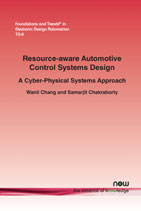Resource-aware Automotive Control Systems Design: A Cyber-Physical Systems Approach
By Wanli Chang, Singapore Institute of Technology, Singapore, wanli.chang@singaporetech.edu.sg | Samarjit Chakraborty, TU Munich, Germany, samarjit@tum.de
Abstract
As the automotive industry is entering the smart era through advances in sensing, computation, storage, communication, and actuation technologies, a larger number of more complex control applications with better performances are expected to be on board. This requires an implementation platform with abundant resources, which is undesired in the cost-sensitive automotive domain. The implementation platform, often embedded in an Electronic Control Unit (ECU) and shared by multiple applications to save cost, is mainly comprised of a processor for computation, memory for storing instructions and data, and bus for internal and external communication. Conventionally, automotive control systems are designed using model-based approaches, where the details of the implementation platform are ignored. Techniques that integrate the characteristics of implementation resources into control algorithms design are largely missing. Such a separate design paradigm is too conservative in resources dimensioning and utilization for modern vehicles. This article presents recently developed approaches in automotive control systems design that take implementation resources into consideration, aiming to improve the control performances for a given amount of resources, or equivalently, realize the required control performances with fewer resources. While communication resources have been extensively explored in the literature of networked embedded control systems, we will focus on memory and computation resources, which have started to receive attention from the academic community and industry just recently. As Electric Vehicles (EVs) have become a new trend in the automotive industry, energy resources of EVs, i.e., the batteries, are also investigated. A number of real-world applications validate the resource-aware automotive systems design techniques presented in this article.
Resource-aware Automotive Control Systems Design: A Cyber-Physical Systems Approach
As the automotive industry faces into the smart era through advances in sensing, computation, storage, communication, and actuation technologies, a larger number of more complex control applications with better performances are expected to be on board. This requires an implementation platform with abundant resources, which is a major challenge in the cost-sensitive automotive domain. The implementation platform, often embedded in an Electronic Control Unit (ECU) and shared by multiple applications to save cost, is mainly comprised of a processor for computation, memory for storing instructions and data, and bus for internal and external communication. Conventionally, automotive control systems are designed using model-based approaches, where the details of the implementation platform are ignored. Techniques that integrate the characteristics of implementation resources into control algorithms design are largely missing. Such a separate design paradigm is too conservative in resources dimensioning and utilization for modern vehicles.
This monograph presents recently developed approaches in automotive control systems design that take implementation resources into consideration, aiming to improve the control performances for a given amount of resources, or equivalently, realize the required control performances with fewer resources. While communication resources have been extensively explored in the literature of networked embedded control systems, this book focuses on memory and computation resources, which have started to receive attention from the academic community and industry just recently. As Electric Vehicles (EVs) have become a new trend in the automotive industry, energy resources of EVs are also investigated. A number of real-world applications validate the resource-aware automotive systems design techniques presented in the monograph. This text will be of interest to researchers and engineers in the automotive, embedded system and control domains.
